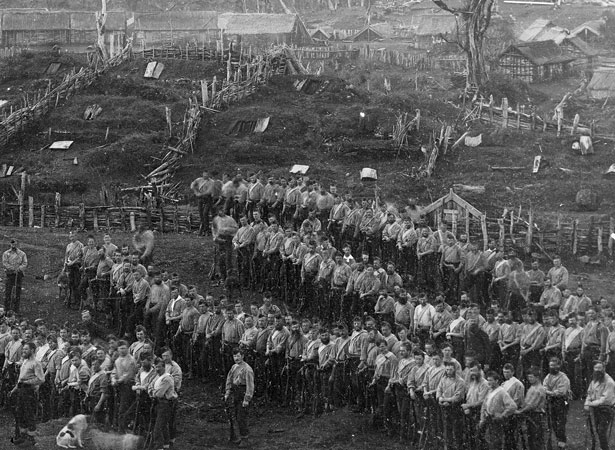
About 1600 troops invaded the western Taranaki settlement of Parihaka, which had come to symbolise peaceful resistance to the confiscation of Māori land.
Founded in the mid-1860s, Parihaka was soon attracting dispossessed and disillusioned Māori from around the country. They were impressed by the kaupapa of its main leaders, Te Whiti-o-Rongomai and Tohu Kākahi, both of the Taranaki and Te Āti Awa iwi.
When in May 1879 the colonial government moved to occupy fertile land on the Waimate Plains that had been declared confiscated in the 1860s, Te Whiti and Tohu developed tactics of non-violent resistance.
Ploughmen from Parihaka fanned out across Taranaki to assert continuing Māori ownership of the land. The government responded with laws targeting the Parihaka protesters and imprisoned several hundred ploughmen without trial.
Following an election in September 1879, the new government announced an enquiry into the confiscations while sending the ploughmen to South Island gaols, where some died. In 1880 the West Coast Commission recommended creating reserves for the Parihaka people. Meanwhile, the government began constructing roads across cultivated land. Men from Parihaka who rebuilt their fences soon joined the ploughmen in detention.
The prisoners were released in early 1881. After ploughing resumed in July, John Hall’s government decided to act decisively while Governor Sir Arthur Gordon was visiting Fiji. A proclamation on 19 October gave the ‘Parihaka natives’ 14 days to accept the reserves offered or face the consequences.
On 5 November, about 1600 volunteers and Constabulary Field Force troops marched on Parihaka. Several thousand Māori sat quietly on the marae as singing children greeted the force led by Native Minister John Bryce. The Whanganui farmer had fought in the campaign against Tītokowaru (see 9 June) and viewed Parihaka as a ‘headquarters of fanaticism and disaffection’. Bryce ordered the arrest of Parihaka’s leaders, the destruction of much of the village and the dispersal of most of its inhabitants. The Sim Commission which investigated these events in the 1920s was told that women were raped by troops, with some bearing children as a result.
Pressmen, officially banned from the scene by Bryce, were ambivalent about the government’s actions, but most colonists approved of them. Te Whiti and Tohu were detained without trial for 16 months. The government managed to delay for several years the publication in New Zealand of the official documents relating to these events.
View the film Tatarakihi: the children of Parihaka (NZ On Screen):
Read more on NZHistory
Prophets and colonists – New Zealand's 19th-century warsTohu KākahiPai Mārire – Pai MarireTe WhitiJohn HallTe Tangata Kohuru: The Murderous Man – Te Tangata Kōhuru: The Murderous Man
External links
How to cite this page
'Invasion of pacifist settlement at Parihaka ', URL: https://nzhistory.govt.nz/occupation-pacifist-settlement-at-parihaka, (Ministry for Culture and Heritage), updated 5-Nov-2021
